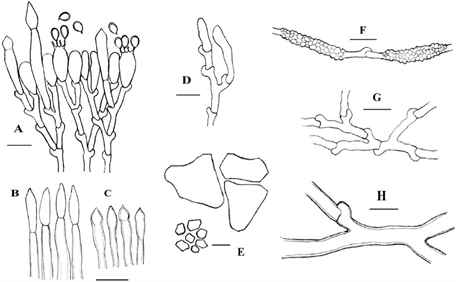Crystallicutis damiettensis El-Gharabawy, Leal-Dutra and G.W. Griff., sp. nov.
MycoBank number: MB 557790; Index Fungorum number: IF 557790; Facesoffungi number: FoF;
Etymology. The species epithet “damiettensis” refers to Damietta University (North Nile Delta, Egypt), close to the location where the fungus was first discovered.
Diagnosis. Basidiome resupinate, honey-yellow, tuberculate to papillate-warty, with waxy texture, white margin. Basidia clavate (6.07.5 × 12.015.0 mm), smooth, thin-walled, 4-spored. Basi-dioles similar in shape but smaller (45 mm diameter). Basidiospores short, ovoid to ellipsoid, tear-shaped, smooth, sometimes thick-walled (3.03.54.05.0 mm), non-amyloid and non- dextrinoid. Cystidia abundant, long, smooth, hyaline, thin-walled, septate (2-celled), spear-shaped (4.05.0 × 2225 mm). Cystidioles are fusiform, 3.04.0 1822 mm. Monomitic hyphal system, with generative hyphae bearing abundant clamps and frequent stumpy branches. Brown, resinous agglomerations and large irregularly-shaped hyaline crystals (1030 2050 mm) are present on the hymenium surface, subhymenium and subiculum. Smaller (14 mm) rhomboid-shaped hyaline crystals are present forming encrustations of hyphae. Differs from other members of this genus in having abundant cystidia and cystidioles.
Typification. The holotype (Figs. 2 and 5) was collected from: EGYPT. Kafr El-Sheikh, Baltim (31.5764◦N, 31.0796◦E; North Nile Delta), growing on fallen trunk of date palm (P. dactylifera) killed by R. ferrugineus, 14 Feb 2014, coll. HM El-Gharabawy, Voucher UN63A is held at (Aberystwyth University biorepository). The ex- type culture UN63A is held in the Aberystwyth University fungal culture collection and also at the Faculty of Science at Damietta University. GenBank: KX428470 (ITS1 spacer, 5.8S rRNA gene, ITS2 spacer, D1eD2 28S rRNA).
Additional specimens examined. Four additional basidiomes found on trunks and stumps of fallen date palms killed by R. ferrugineus in the same orchard at Baltim, Kafr El-Sheikh (31.5764◦N, 31.0796◦E), AugeDec 2017; vouchers UN63B, UN63C, UN63X, UN63Y; coll. HM El-Gharabawy, held at the Faculty of Science at Damietta University. Ten basidiomes, on trunks and stumps of fallen date palms killed by R. ferrugineus, at El-Sinaniah, Damietta (31.4429◦N, 31.7798◦E), Jan 2018eFeb 2020; vouchers UN1-UN10; coll. HM El-Gharabawy, held at the Faculty of Science at Damietta University.
Distribution. Nile Delta region of Egypt. Hitherto only found on fallen and heavily-rotted trunks or stumps of P. dactylifera (datepalm).
Notes: White-rot decay mechanism with secretion of Mn- dependent and Mn independent peroxidases, but only low and transient secretion of laccase (El-Gharabawy et al., 2016).

Fig. 2. Detailed view of resupinate basidiomes of Crystallicutis damiettensis in the field. The resupinate basidiomes are honey yellow coloured with a granulated (papillate) surface and white thin fibrous margin when young (A). Thicker velvety mats with a warty (bullate) surface, irregularly crenulated and a waxy appearance are also found (B). Older basidiomes are buff to pale brown with white margins and cracked (C), with the surface becoming smoother with a dull (not waxy) appearance, concolorous flesh and soft dense texture (D). Scale bar indicates 1 cm. (For interpretation of the references to colour in this figure legend, the reader is referred to the Web version of this article.)

Fig. 5. Diagram of microscopic structures of Crystallicutis damiettensis basidiome. Hymenium layer with clavate 4-spored basidia, thick-walled basidiospores, smaller basidioles and basal clamps (A). Cystidia are spear-shaped (B) or fusiform (C), with cystidioles also present (D). Large and small hyaline crystals (E) and other encrustation on hyphae were observed (F). Generative hyphae with abundant clamps (G) and pseudo-skeletoid subicular hyphae (H) are present. Scale bar indicates 10 mm.
